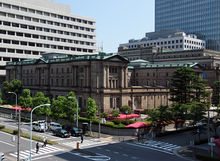
Back بنك اليابان Arabic Bancu de Xapón AST Yaponiya bankı Azerbaijani জাপান ব্যাংক Bengali/Bangla Bank of Japan German Banko de Japanio Esperanto Banco de Japón Spanish بانک ژاپن Persian Japanin pankki Finnish Banque du Japon French
 | |
 | |
| Headquarters | Chūō, Tokyo, Japan |
|---|---|
| Coordinates | 35°41′10″N 139°46′17″E / 35.6861°N 139.7715°E |
| Established | 27 June/10 October 1882 |
| Ownership | At least 55% of all capital must be owned by the Government of Japan[a] |
| Governor | Kazuo Ueda (9 April 2023 – present) |
| Central bank of | |
| Currency | Japanese yen JPY (ISO 4217) |
| Reserves | US$1.12 trillion (October 2023)[2] |
| Bank rate | +0.25%[3] |
| Website | boj.or.jp |
The Bank of Japan (日本銀行, Nippon Ginkō, BOJ) is the central bank of Japan.[4] The bank is often called Nichigin (日銀) for short. It is headquartered in Nihonbashi, Chūō, Tokyo.[5]
The bank is a corporate entity independent of the Japanese government,[1] and while it is not an administrative organisation of the state, its monetary policy falls within the scope of administration. From a macroeconomic perspective, long-term stability of prices is deemed crucial. However, the political sector tends to favour short-term measures. Thus, the bank's autonomy and independence are granted from the standpoint of ensuring long-term public welfare and political neutrality.[6]
- ^ a b "Outline of the Bank : 日本銀行 Bank of Japan". Bank of Japan. Retrieved 18 February 2024.
- ^ Weidner, Jan (2017). "The Organisation and Structure of Central Banks" (PDF). Katalog der Deutschen Nationalbibliothek. Archived from the original on 28 May 2020. Retrieved 14 May 2020.
- ^ da Silva, João (31 July 2024). "Japan hikes interest rates for second time since 2007". BBC. Retrieved 31 July 2024.
- ^ Nussbaum, Louis Frédéric. (2005). "Nihon Ginkō" in Japan encyclopedia, p. 708., p. 708, at Google Books
- ^ "Guide Map to the Bank of Japan Tokyo Head Office. Archived 2009-06-04 at the Wayback Machine". Bank of Japan. Retrieved 22 December 2009.
- ^ "金融制度調査会". www.fsa.go.jp. Retrieved 18 February 2024.
Cite error: There are <ref group=lower-alpha> tags or {{efn}} templates on this page, but the references will not show without a {{reflist|group=lower-alpha}} template or {{notelist}} template (see the help page).